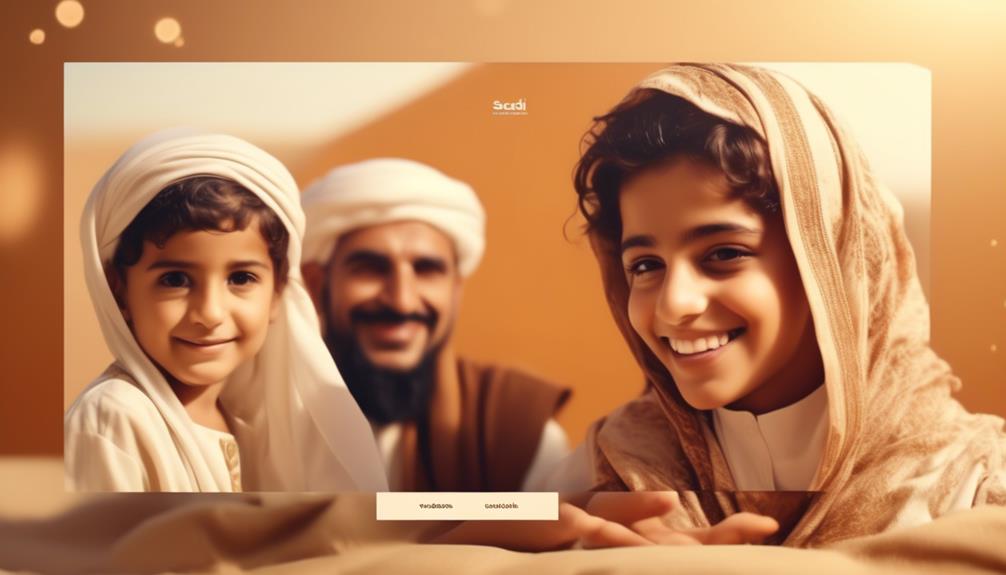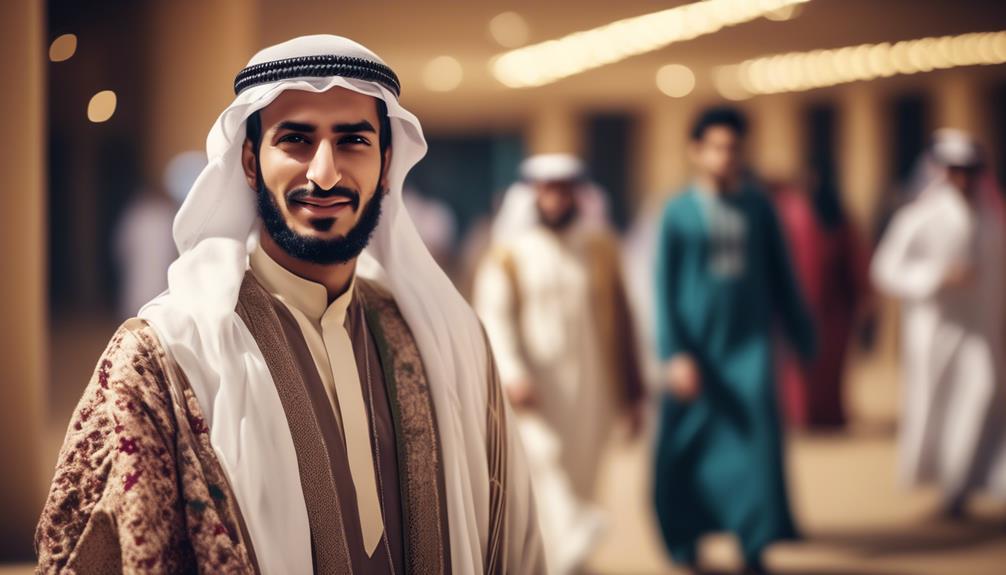In today's rapidly globalizing world, it is essential for web designers to understand and cater to the cultural nuances and traditions of different countries. Saudi Arabia, with its rich history and strong cultural heritage, presents a unique set of considerations for web design.
From the importance of the Arabic language to the incorporation of family values, there are several key tips that can help shape web design in Saudi Arabia. By understanding and implementing these tips, designers can create websites that not only cater to the specific needs of the Saudi audience but also provide a seamless and engaging user experience.
So, let's explore the six tips that highlight how Saudi traditions shape web design and how they can be effectively integrated to create culturally sensitive and appealing websites.
Importance of Arabic Language

The Arabic language plays a pivotal role in shaping the web design landscape in Saudi Arabia. With its deep cultural symbolism and rich visual aesthetics, Arabic script is not just a means of communication but also a powerful tool for creating visually appealing and culturally relevant websites.
Arabic calligraphy, with its intricate and ornate letterforms, holds a special place in Saudi Arabian culture. It is not only seen as a form of artistic expression but also as a reflection of the country's Islamic heritage. Web designers in Saudi Arabia often incorporate Arabic calligraphy in their designs to create a sense of authenticity and cultural identity. This can be seen in the use of calligraphic fonts for headings, logos, and other prominent design elements.
Furthermore, the Arabic language itself has unique characteristics that influence web design choices. For example, Arabic is read from right to left, which requires designers to adapt their layouts accordingly. This affects the placement of navigation menus, text alignment, and overall page structure.
Significance of Calligraphy
Calligraphy holds immense cultural and artistic value in Saudi Arabia, profoundly influencing the web design landscape in the country. The evolution of calligraphy in Saudi Arabia has played a significant role in shaping the country's typography and, subsequently, its web design aesthetics.
Calligraphy has a long and rich history in Saudi Arabia, dating back centuries. It is considered a highly respected art form, with skilled calligraphers being held in high esteem. The intricate and detailed nature of calligraphy in Saudi Arabia has had a profound impact on the country's typography.
The influence of calligraphy on typography is evident in Saudi Arabia's web design. Many websites incorporate calligraphic elements in their designs, such as elegant and stylized Arabic fonts. These fonts not only enhance the visual appeal of the websites but also reflect the cultural heritage of the country.
Moreover, calligraphy has influenced the layout and arrangement of text in Saudi Arabian web design. The flowing and artistic nature of calligraphy has inspired designers to create visually appealing compositions, where text is arranged in a harmonious and balanced manner.
Incorporating Family Values

As Saudi Arabia's web design landscape continues to evolve, it is evident that incorporating family values has become an essential aspect of the design process, building upon the rich cultural influence of calligraphy.
In Saudi Arabian society, family holds great importance, and web designers are now recognizing the significance of reflecting these values in their designs.
One way in which family values are incorporated into web design is through the promotion of gender equality. Saudi Arabia has made significant strides in recent years to empower women and promote gender equality. Web designers are now ensuring that their designs reflect this progress by creating inclusive and gender-neutral interfaces. This not only aligns with the country's vision for a more equal society but also helps in creating a positive user experience for all individuals.
In addition to gender equality, web designers are also focusing on community engagement. Family is the cornerstone of Saudi Arabian society, and community engagement plays a vital role in fostering a sense of togetherness. Web designers are incorporating features that facilitate community interaction, such as discussion forums, social media integration, and event calendars. These features encourage users to engage with one another, fostering a sense of belonging and strengthening the community bonds.
Emphasizing Modesty in Layout
Emphasizing modesty in layout is a fundamental aspect of web design in Saudi Arabia, reflecting the cultural values and traditions of the society. Saudi Arabia is known for its conservative approach, and this is also reflected in the design of websites. The concept of modesty extends beyond clothing and behavior; it also encompasses the visual presentation of websites.
One way to emphasize modesty in web design is through the use of symbolic colors. In Saudi Arabia, certain colors hold cultural significance and are often associated with religious traditions. These colors, such as green and white, can be incorporated into the layout to create a sense of harmony and respect for cultural norms.
Another approach to emphasize modesty is through a minimalistic design. By keeping the layout simple and uncluttered, web designers can create an aesthetic that aligns with the values of modesty and simplicity. This can involve using clean lines, ample white space, and a restrained use of visuals and graphics.
Cultural Sensitivity in Imagery

Cultural sensitivity in imagery is a crucial consideration in web design, as it ensures that the visuals used align with the cultural values and traditions of Saudi Arabia. Visual representation plays a significant role in shaping the user experience, and it is essential to be mindful of the cultural context when selecting images for a website.
One key aspect of cultural sensitivity in Saudi Arabia is gender segregation. It is important to avoid using images that depict men and women interacting intimately or in a way that may be seen as inappropriate. Instead, web designers should opt for visual representations that reflect the gender norms of the country, such as separate images of men and women or images that show individuals in gender-segregated settings.
Furthermore, it is crucial to consider the modesty standards in Saudi Arabian culture when selecting imagery. Women should be portrayed in conservative attire with their bodies covered, and men should be depicted in modest clothing as well. By respecting these cultural norms, web designers can create a visually appealing and culturally sensitive online experience for Saudi Arabian users.
Adapting to Islamic Calendar and Holidays
One important aspect to consider in web design for Saudi Arabia is the adaptation to the Islamic calendar and holidays. Adapting to cultural norms and designing for local customs are crucial for creating a website that resonates with the Saudi audience. The Islamic calendar follows a lunar system, which means that the dates of Islamic holidays and observances vary each year in relation to the Gregorian calendar. It is essential to incorporate features that highlight these holidays and provide relevant information to users.
When designing for Islamic holidays, it's important to understand the significance and customs associated with each occasion. For example, during Ramadan, the holy month of fasting, it is customary for Muslims to abstain from food and drink from sunrise to sunset. Web designers should be mindful of this and consider creating designs that are respectful and accommodating to those observing the fast. Additionally, it may be beneficial to include features such as prayer time reminders and access to Islamic resources.
Furthermore, it is essential to be aware of other significant Islamic holidays such as Eid al-Fitr and Eid al-Adha. These celebrations are marked by feasting, gift-giving, and gatherings with family and friends. Incorporating festive and joyous elements into the website design during these occasions can help create a sense of belonging and celebration for users.
Frequently Asked Questions
What Are Some Common Design Elements Used to Incorporate Family Values in Saudi Web Design?
Incorporating cultural symbolism and navigating gender roles in design are common elements used to incorporate family values in Saudi web design. These design choices reflect the cultural heritage and traditional values of Saudi society.
How Does the Emphasis on Modesty in Layout Affect the Overall User Experience?
Emphasizing modesty in layout is a key aspect of web design in Saudi Arabia. This focus on minimalism creates a clean and uncluttered user experience. Additionally, the use of color psychology helps evoke emotions and enhance overall user satisfaction.
What Are Some Examples of Cultural Sensitivity in Imagery That Are Commonly Seen in Saudi Web Design?
Cultural sensitivity in Saudi web design is evident through the use of imagery that respects traditional clothing norms. Examples include showcasing individuals wearing abayas and thobes, and incorporating culturally significant symbols and patterns.
How Do Saudi Web Designers Adapt Their Designs to Reflect the Islamic Calendar and Holidays?
Saudi web designers adapt their designs to reflect the Islamic calendar and holidays by incorporating traditional patterns and designing for accessibility. This allows them to create visually appealing and culturally sensitive websites that resonate with their audience.
How Does the Arabic Language Play a Role in Shaping the Overall Design of Saudi Websites?
The Arabic language plays a significant role in shaping the overall design of Saudi websites by incorporating Arabic calligraphy and cultural symbolism. It adds a sense of identity and authenticity, reflecting the country's rich heritage and traditions.
Conclusion
In conclusion, Saudi traditions play a significant role in shaping web design.
The importance of the Arabic language and calligraphy, as well as the incorporation of family values and emphasis on modesty in layout, are key factors.
Cultural sensitivity in imagery and the adaptation to the Islamic calendar and holidays are also crucial in creating a website that resonates with Saudi users.
By understanding and incorporating these traditions, web designers can effectively connect with the Saudi audience.

